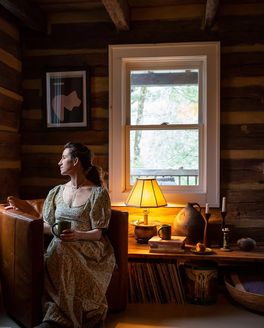
Black Mountain: The Way We Played
This season, we introduced two new colors to our core collection—Blue Ridge and Black Mountain, named in celebration of our local region.
Journalist-historian Cynthia Greenlee has family roots in Black Mountain and will be leading us through an exploration of her Black Mountain—past, present, and future.
Read Part 1 here.
Read Part 2 here.
Last year, my cousin Cheryl gave me a tiny image of my father, Ralph Greenlee. No larger than a book of postage stamps, it quickly became my favorite photograph of my father, who died during the first week of pandemic lockdown in April 2020.

She told me the photograph was likely taken circa the early 1950s in the adjacent hamlet of Ridgecrest, near the barns of the Baptist Assembly. My father worked wrangling horses and teaching riding at local camps or leading horsepacking expeditions in the Pisgah National Forest.
It's one of the few pictures I have of my dashing young father, who was valedictorian of his class at Stephens-Lee High and pitcher on its baseball team.
In the image, I see the young outdoorsman and daredevil my late father once was, before he lost a leg while serving in the Army overseas in Germany. In his last years, he loved looking back at his former self, ablebodied and active. In his profile and his crouch over the bay horse's back in this picture, I see both concentration and skill.
He's clean-shaven and neatly dressed, in a white shirt and what appear to be khaki pants. It's not the usual uniform of a stable worker tending these large, four-legged beasts. But I'm guessing that he's jumping for show, perhaps in order to entertain the blurry group of white adults in the bottom right of the frame.
They are not the center of the photograph, and I appreciate it. Whenever I observe or study a community, I look for how people play. That goes doubly for Appalachian people, since stories about the region tend to default to descriptors with the word "hard" embedded in them. Hardscrabble. Hard work. Hard times. Hardship. A whole lot of “hard.”
I want to know how Black people rest and play — outside of the white gaze — even more urgently. It’s easy to reduce our lives to The Struggle, the accumulation of perpetual racist insults and constraints, rather than seeing our experiences three-dimensionally.
As a historian, I'm suspicious of how easily both Appalachian and African-American narratives fall back on precarity, survival, poverty and tradition as their main tropes. All people need to let off steam and transcend the rough stuff of daily existence, even when free time is scarce and freedom is even more elusive. We all need #TheSoftLife sometimes. And perhaps we play harder when life is stingy and segregated.
Asheville has rich, publicly accessible African-American photographic archives, namely the Isaiah Rice collection that documents mid-20th century Black life in the city and the Andrea Clark photographs that captured the dying days of legal segregation and the changes in Asheville’s East End.
But what of life in rural Buncombe? And of family photography, those hidden archives that keep so much Black history stuck to yellowing scrapbook pages?

It's a special treat to see my adolescent father rolling his niece along on a bicycle. Maybe my father is looking at the person behind the camera mischievously. Or he's responding to an order to be careful balancing this small girl — the same cousin Cheryl who gave me my-father-as-equestrian image — on the handlebars. There's a sweetness and lightness here, of two young people at play. I love the homeliness of this physical photograph, with its deckle edges. It's creased, just like the image of chubby, pre-K me banging on piano during a family reunion at Christmount, a religious retreat in Black Mountain. Those creases say: "These pictures and these people have been loved."

I delight in an image of my aunts Erlene Hamilton (left) and Margaret Clinkscales smiling and waving in a ski lift above pastureland. As a child, I associated my aunts so strongly with this one place. It seemed like they were always there, part of the very landscape itself. Maybe they had emerged from the mountains, like Aphrodite rose from seafoam. But they made their way to places like Pittsburgh and Ohio, where the Great Migration took family members and where kinfolk sometimes followed Negro League baseball and other amusements.
Aunt Margaret was one of the pre-eminent photographers of the family, proudly keeping Polaroids and pictures she took first with a Brownie camera, collecting others’ photographs in scrapbooks. Decked out in sunglasses, Aunts Lene and Margaret both clutched their purses while cruising among the clouds. I love to see them this way, waving to me from history, quietly confident that someone — a loving husband, cautious cousins, friends who never went anywhere — would want a record of this moment, this shared adventure and who they were.



